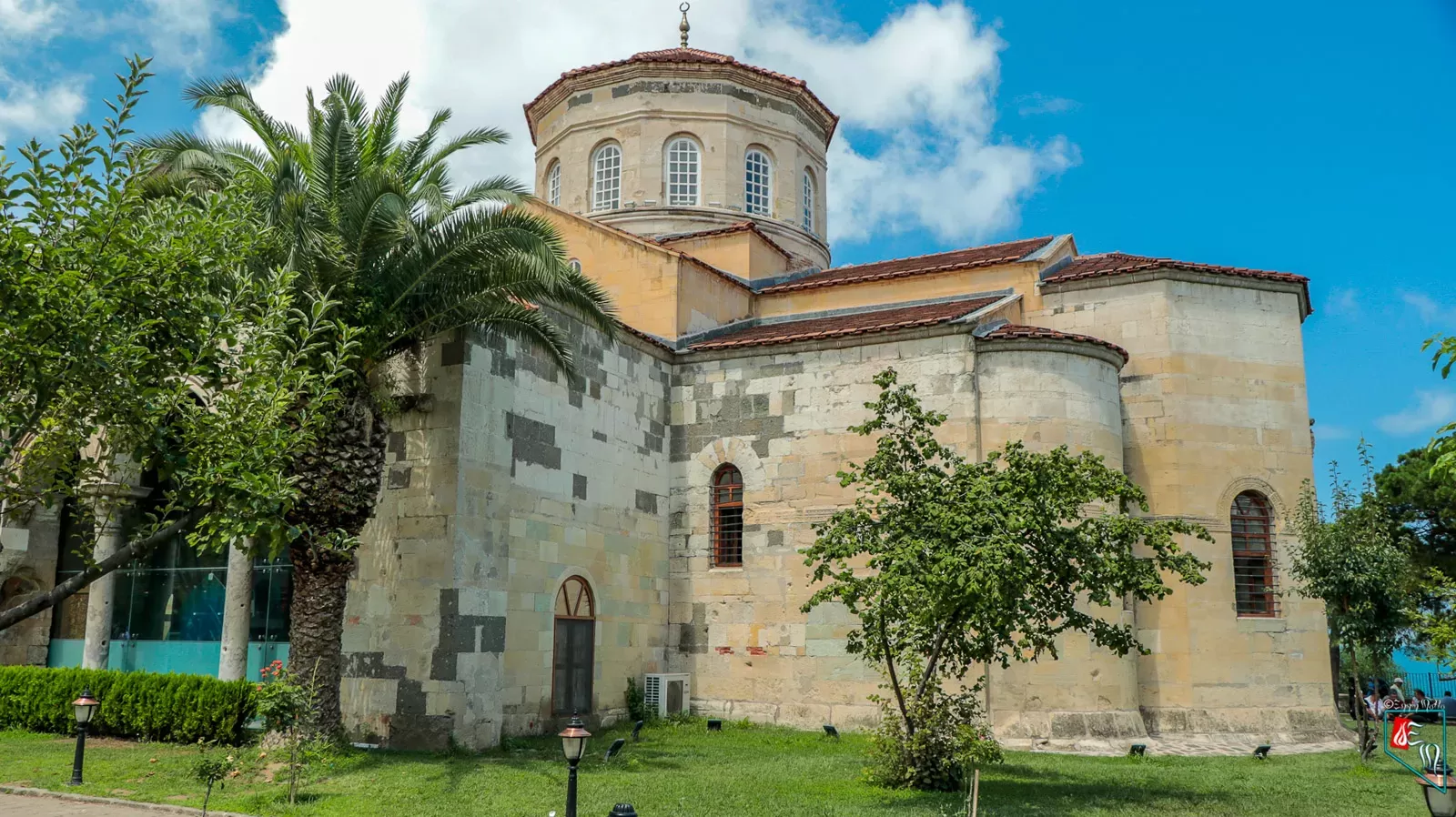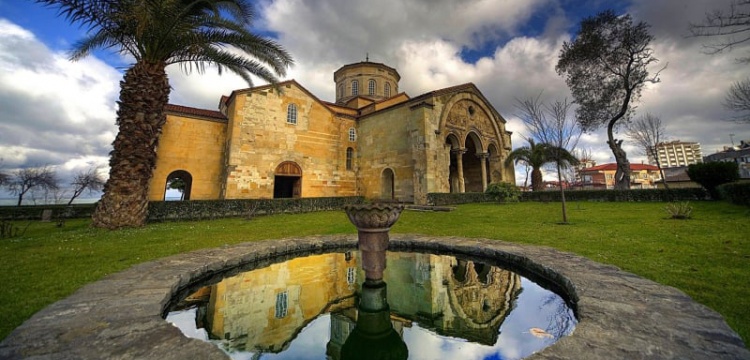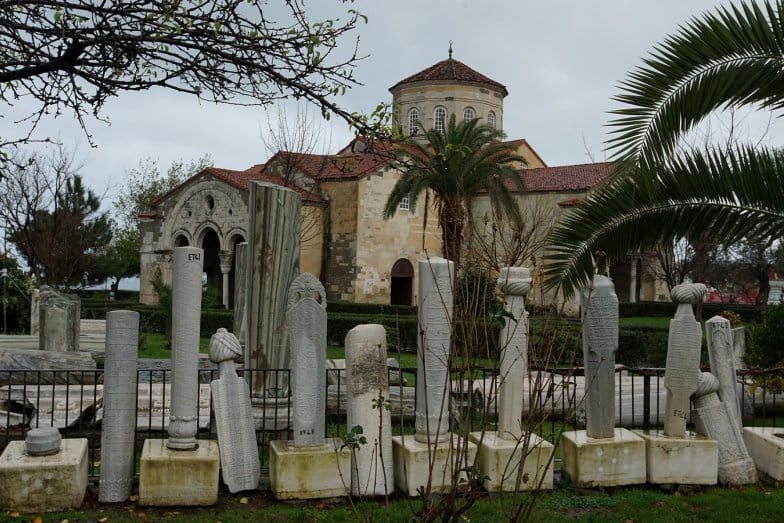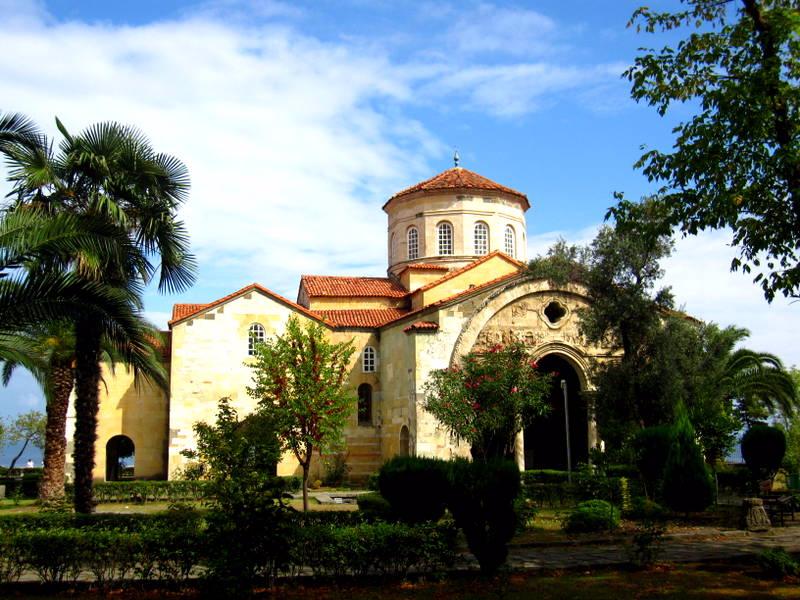If you're looking for a place in Trabzon that overlooks the sea, holds the whispers of history within its walls, and mesmerizes with its art, where would you turn your compass? When you think of Trabzon, the pearl of the Black Sea, lush green plateaus, the grandeur of Sumela, or the tranquility of Uzungol immediately come to mind. But in the heart of the city, amidst all this natural beauty, lies a treasure at the crossroads of empires, religions, and art. In this article, we'll show you why a list of things to do in Trabzon Hagia Sophia is so much more than just a 'museum visit'. We invite you to explore an 800-year-old architectural marvel, read the ancient stories on its walls, and take a breath in its peaceful garden against the Black Sea.
Explore the structure, one of the finest examples of the late Byzantine period

When you step through the doors of Hagia Sophia, you enter not just a building, but a living history. This place was built as a monastery church between 1238 and 1263 by King Manuel I of the Komnenos dynasty, who ruled the Empire of Trebizond. At that time, this empire was like a small Byzantium on the Black Sea coast, and this monument reflects its power and wealth.
The architecture will immediately captivate you. Considered one of the most elegant examples of late Byzantine architecture, Hagia Sophia stands out with its high-drummed central dome and cross-in-square plan. But what makes this place truly special is that it's not purely Byzantine. If you look closely at the stonework on its walls, you'll see traces of Seljuk art; geometric medallions and muqarnas niches are proof of how Trabzon was a cultural crossroads. This architectural synthesis is the story of the Trebizond Empire's complex relationships with its powerful Seljuk and Georgian neighbors, carved in stone.
The most magnificent facade of the building is on the south side. Here, a bas-relief frieze depicting the creation of Adam and Eve showcases the incredible skill of the stone masters. On the keystone of the arch, you will see the single-headed eagle motif, the symbol of the Komnenos dynasty; it is a signature that seals the building's identity and the era it belongs to. The story of Hagia Sophia, like the city itself, is layered. Just like the many
(https://www.yerelrehber.com/en/city/trabzon), it bears the mark of a different civilization in every corner. Its conversion into a mosque after the conquest, its use as a warehouse and hospital by the Russians during World War I, its transformation into a museum in 1964, and its reopening for worship as a mosque in 2013 summarize what these walls have witnessed.
Examine scenes from the Bible in the well-preserved frescoes

The soul of Trabzon's Hagia Sophia is hidden in the paintings on its walls, the frescoes. There's an interesting story behind how these frescoes have survived so vividly to this day. When the building was converted into a mosque, these religious depictions were covered with plaster. This act, intended to hide them, ironically protected the frescoes from the ravages of centuries, turning them into a time capsule.
When you turn your eyes up to the main dome, you are greeted by the impressive depiction of Christ Pantocrator, meaning Christ the Almighty. Just below him, a choir of angels and the twelve apostles are placed on the twelve-sided drum of the dome. On the walls, a pictorial Bible awaits you. Scenes such as the birth of Jesus, his baptism, crucifixion, and the Last Judgment are rendered with magnificent details that reflect the artistic understanding and faith of that period. These paintings are considered among the earliest examples of the Palaeologan Renaissance, a period of renewal in Byzantine art, which makes them invaluable from an art history perspective.
There is an important detail you should know as a visitor. Since the building is used as an active mosque today, some of the frescoes in the prayer area are covered by a special system during prayer times. This might seem like a disappointment at first, but think of it as the latest chapter in the building's living history. During your visit, you are witnessing the most current moment in the centuries-long dialogue between faith, art, and power within these walls. For the best-preserved and always visible frescoes, don't forget to head to the narthex, the entrance hall; the scenes here will mesmerize you.
Sit in the museum's garden and have a tea facing the Black Sea

After absorbing the grandeur of the architecture and the depth of the frescoes, the best thing to do is to step out into the peaceful garden of Hagia Sophia. This is where you'll find that perfect, calm moment to complete your visit. Although these walls, which once heard the sound of the waves, are now a bit inland due to the coastal road built on sea fill, the blue of the Black Sea still greets you from a distance.
Order a strong black tea from the tea house in the garden and take a seat at one of the tables in the shade of the ancient walls. With a warm glass of tea in your hand, 800 years of history before you, and the fresh air of the Black Sea... This is the perfect time to piece together all the art you've seen and the stories you've heard. You can appreciate the building's form, its stonework, and how it has defied time as a whole from the outside.
This break is not just for resting your feet, but for feeling the soul of Trabzon. The tea you drink here might inspire you to discover more about the (https://www.yerelrehber.com/en/explore/things-to-do/trabzon-flavors). This garden, intertwined with history, so close to the flow of modern life yet so far from it, is an inseparable part of the Hagia Sophia experience.
While You're Here...
If you still have energy after exploring Hagia Sophia, don't leave without discovering a few other wonderful spots nearby.
Atatürk Mansion: Located on the Soğuksu ridges among pine trees, this elegant mansion will take you back to the early years of the Republic. The building where Atatürk stayed during his visits to Trabzon and wrote part of his will is ideal for breathing in the history of a different era.
Boztepe: From Boztepe, which is like the roof of the city, you can get a bird's-eye view of all of Trabzon and the Hagia Sophia you just visited. A cup of tea or coffee with the view will add pleasure to your day.
Sera Lake: If you want to spend some time with nature after the historical sites, this natural wonder formed by a landslide is just for you. Located quite close to the center of Trabzon, you can take a boat trip on the lake or enjoy a peaceful walk around it.
Frequently Asked Questions (FAQ)
1. Is there an entrance fee for Trabzon Hagia Sophia? (Current for 2025) Yes and no. The ground floor of Hagia Sophia, which is open for worship as a mosque, is free to enter. However, the upper floor (gallery/museum section), where the historical frescoes and architectural details can be examined more closely, is paid. Fees vary according to the visitor type.
| Visitor Type | Area | 2025 Fee (Estimated) |
|---|---|---|
| Everyone (Worship/Visit) | Ground Floor (Mosque Area) | Free |
| Turkish Citizens | Upper Floor (Gallery/Museum) | 800 – 850 TL |
| MuseumCard Holders | Upper Floor (Gallery/Museum) | 425 TL |
| Foreign Visitors | Upper Floor (Gallery/Museum) | €25
|
2. What are the visiting hours for Trabzon Hagia Sophia? The museum/gallery section generally opens at 09:00 and is open until 19:00 in the summer and 17:00 in the winter. The mosque section can be visited throughout the day outside of prayer times. However, since it may be closed to tourist visits during prayer times, it's a good idea to keep this in mind when planning your visit.
3. Is there a special dress code for the visit? Yes, as the building is an active mosque, modest dress is expected out of respect. Visitors should wear clothes that cover their shoulders and knees, and it is recommended that women bring a scarf to cover their hair. Headscarves and appropriate clothing are available at the entrance for those who need them.
Reference: For more official information and updates, you can visit the (https://www.ktb.gov.tr/?_Dil=2) website.


 English
English Türkçe
Türkçe